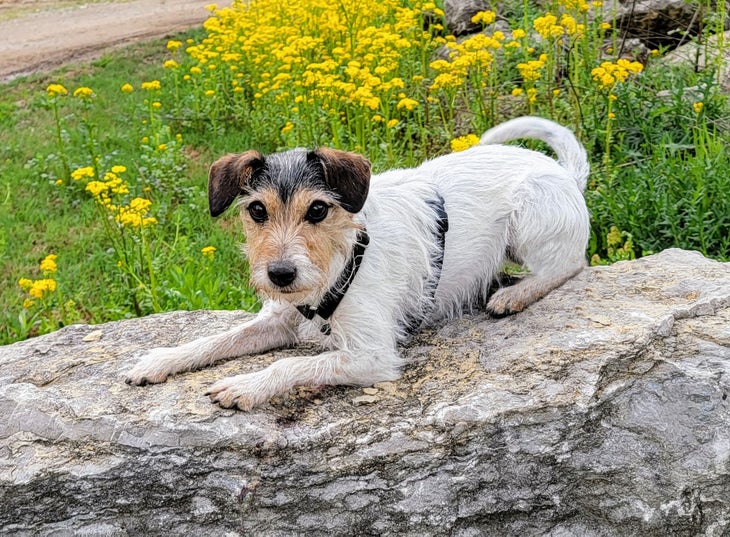Pocket the search dog was two years old when she saved her first missing person. It was 2015 and a young boy had vanished in the woods near Louisville, Kentucky. A police search had come up empty. But Pocket is a Parson Russell Terrier, a dog with a powerful nose that was originally bred to hunt foxes in the Welsh countryside. She picked up the boy’s scent and led officials to a field near his school, where they found him sitting near a tree, too scared to speak. When the boy refused to move or even to drink water, Pocket’s trainer, a woman named Jennifer Jordan Hall, asked him if he wanted to pet the dog.
“I asked him if he’d like to share Pocket’s water,” Hall said. The dog seemed to put the boy at ease, and Hall and Pocket eventually escorted him home.
Since then, Pocket has become one of the most successful search dogs in the country: she has participated in multiple searches for missing persons and excels in the detection of human remains. Earlier this month, the American Kennel Club—the largest registry of purebred dogs in the country—gave Pocket its annual award for .
“Pocket is tenacious, determined, hardworking, and will do anything to find her person,” Hall told me. “When she found her first person alive I said, ‘We can die now. We’ve done something good.”
The award marks a major professional milestone for both Pocket and Hall. Hall said she had trouble finding acceptance in law enforcement circles when she began assisting on search and rescue cases in 2006 with a prior dog. Pocket looks somewhat out of place among the German Shepherds and Belgian Malinois that typically make up a K-9 search and rescue team. Pocket is actually the third terrier Hall has trained in trailing scent and human remains detection—she’s currently training her fourth, a two-and-a-half year old terrier named Wick.
These days, families of missing persons specifically seek out Hall and Pocket near their home in Louisville. Now ten years old, Pocket has also assisted in searches across the nation. But Hall says the two weren’t always accepted.

“The law enforcement culture wasn’t always receptive to a small dog showing up,” Hall said. “It put me through a lot of tears—we had to work harder. But once they saw what we could do, after we found a live person, we had a lot of people say ‘call the lady with the white dogs!’”
Finding the Living and the Dead
Hall told me several stories of Pocket’s success. A few years ago, a woman was lost in a region called the Knobs outside of Louisville. The gumdrop-shaped hills feature steep, challenging terrain, and the local sheriff asked Hall and Pocket to follow the missing woman’s scent. Law enforcement had been using infrared cameras to search for heat signatures near the Knobs to no avail.
“It was so steep and hard. The weather had been very hot and I was worried the conditions would be too difficult for Pocket,” Hall said. But Pocket ended up trailing the scent to a ravine. The woman had fallen and hit her head. She was disoriented but lucky to be alive. “Once she recovered she reached out to thank Pocket personally,” Hall said.
Sometimes, Pocket’s must embark on a more macabre task of finding a dead body. But these missions are similarly important, because they bring about closure to families. Hall cross-trained Pocket with her previous Parson Russell Terrier named Scout, to learn how to detect human remains. When Pocket was two, Hall took her and Scout on a mission to find a man who had been missing in a rugged region of rural Kentucky.

As detectives stood atop a slope near the missing man’s last known whereabouts, Pocket sniffed near their feet and alerted them to a pile of coyote scat. There was a strand of green fiber in it that matched the man’s clothing. The detectives were startled and began fanning out and making assumptions about the victim’s path, but Pocket sniffed the ground a few feet from them and found skull fragments. The police combed the area and found 15 disarticulated bones belonging to the victim. The find gave the man’s family closure, Hall said.
The victim’s daughter was so relieved, she gave Hall and Pocket some of the bones to use for training purposes. Hall says those bones helped Pocket become one of the best dogs in the country at locating human remains.
“That family has been with us—they remain a part of what we do,” Hall said. “We’re really lucky.”
Pocket’s knack for locating human remains has also made her an important resource for archaeological digs. These days Pocket works with the Miami Tribe of Oklahoma to help locate and protect ancient burial sites. In one of Pocket’s first projects with the tribe, officials brought her to a construction site where they believed 1,000-year-old tribal remains were buried. Ground-penetrating radar had not been able to detect any distinct bodies, but tribal officials insisted that work crews not disturb a the site, which they believed to be sacred.
When Pocket began sniffing the site, she laid down on the ground near a patch of soil and began to cry. Searchers found human human remains on the spot, Hill said. Eventually, the dog identified 11 distinct piles of remains, and construction was halted.
Now, Pocket is requested by name in any case involving digging near tribal land of the Miami Tribe of Oklahoma. Hall says she’s received multiple calls asking her, “Is there a breed of dog called ‘Pocket? We’ve been told to only accept Pocket dogs,’” she said.
News of Pocket’s award from the American Kennel Club has made her a celebrity in Louisville, and local news stations covered her victory. In a video produced by the AKC, a man named Kevin Thomas shared his anecdote about working with Hall and Pocket to find the body of his missing niece. Pocket located her remains down a steep embankment, and while the discovery was tragic, it also allowed Thomas and his family to grieve and accept closure on the missing girl. “There’s a connection between [Hall and Pocket] that’s magic,” Thomas said. “They didn’t want money, they just wanted to help. I think all of us walked away seeing life a little differently.”


